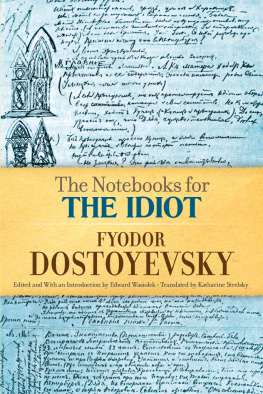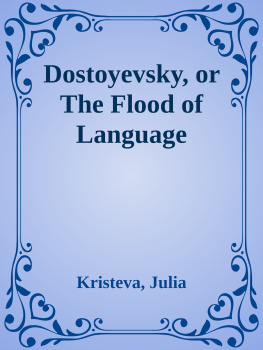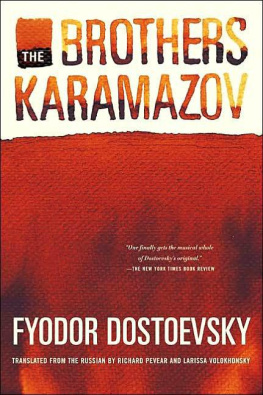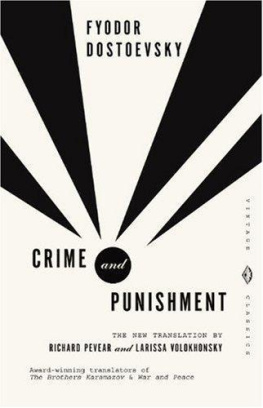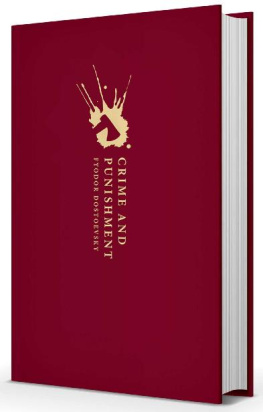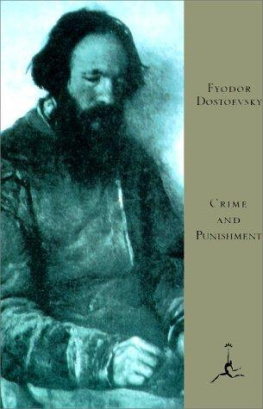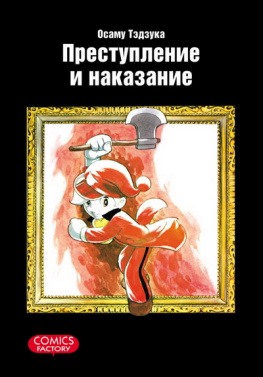The Notebooks for
CRIME & PUNISHMENT
FYODOR
DOSTOYEVSKY
Edited, Translated and With an Introduction by Edward Wasiolek
DOVER PUBLICATIONS, INC.
Mineola, New York
Copyright
Copyright 1967 by The University of Chicago
All rights reserved.
Bibliographical Note
This Dover edition, first published in 2017, is an unabridged republication of the work originally published as Fyodor Dostoevsky: The Notebooks for Crime and Punishment by The University of Chicago Press, Chicago, in 1967. For this edition, we have retained the spelling of the authors name as Dostoevsky as it appears in the 1967 translation. The 1967 translation is based upon the Russian edition of Dostoevskys notebooks: Iz arkhiva F. M. Dostoevskogo: Prestuplenie i nakazanie, Neizdannye materialy, edited by I. I. Glivenko (Moscow and Leningrad, 1931).
International Standard Book Number
ISBN-13: 978-0-486-81370-7
ISBN-10: 0-486-81370-3
Manufactured in the United States by LSC Communications
81370301 2017
www.doverpublications.com
Contents
Illustrations
The illustrations included in this edition of Dostoevskys Notebooks for Crime and Punishment are facsimiles of original pages of the notebooks.
Introduction
I
The notebooks for Crime and Punishment first came to the attention of the general public in 1921, when a representative of the Soviet government in the presence of A. V. Lunacharsky, Assistant Commissar of Education, opened a white tin case left to the State Archives by Dostoevskys widow. Among articles, letters, and various documents was a listing by Anna Grigorievna of fifteen notebooks kept by Dostoevsky. She had numbered each of the notebooks and briefly described its contents. The notes for Crime and Punishment were contained in the first three notebooks. They were subsequently published in full by I. I. Glivenko in 1931, and the present volume is a translation of Glivenkos edition.
The notebooks today are housed in a special archive of the Central Government Archives in Moscow. In 1963 I obtained permission to examine a number of them. They are hard-covered copybooks, about nine by ten inches in size, bound in faded darkish maroon cloth. Dostoevskys handwriting is remarkably clear, uniform, and regular; he evidently took pride in it. On a number of pages he practiced calligraphy and has left us specimens of his skill. He also left examples of his skill at drawing, for the notebooks have many sketches, most frequently of male figures and medieval churches. Some of these pages are reproduced as illustrations in the body of the text.
The Soviet edition is a good and faithful edition. The task of editing was not easy, despite the clarity of Dostoevskys handwriting. His notebooks are in every respect working notebooks. They contain drawings, jottings about practical matters, doodlings of various sorts, calculations about pressing expenses, sketches, and random remarks. The text itself is often scattered about the pages: there are crossings-out, insertions, marginal matter in great abundance, and writing slanted in various directions across the pages. Sometimes Dostoevsky begins in the middle of the page and fills in the right-hand side before turning to the left. Sometimes he crosses out and puts the variant above or below the crossed-out material or in the margin. In addition, he apparently used the notebooks in a random and unsystematic manner, skipping pages and then returning to the empty pages with different matter and even with comments on a different work. At times too he turned the notebook upside down and proceeded from back to front.
Dostoevskys capriciousness makes the dating of the notebooks difficult; but it seems fairly clear that his wife Anna Grigorievna misnumbered them and that Notebook Two was used before Notebook One. We have a few indications in the notebooks themselves that permit us to date them approximately: the dated rough drafts of two letters to Katkov, the editor of The Russian Messenger, and a few dates scattered here and there. On the basis of these hints, we can assume that the material for the second notebook covers approximately September to October of 1865, the first notebook November to December, and the third notebook from January to February of 1866, or in sum the notebooks date from September of 1865 to February of 1866. In the absence of incontestable evidence, however, I have not changed the numbering of the notebooks. In September of 1865 Dostoevsky had written Katkov that he had been working on Crime and Punishment for about two months, and the serialized publication of Crime and Punishment began the following January. The three notebooks, therefore, start about two months after Dostoevsky began writing Crime and Punishment and continue for a few months after the first instalment appeared in The Russian Messenger.
We have no idea, of course, whether this material represents the bulk of his working notes for the novel. They have a fragmental and partial character, and it seems reasonable to assume that they are only a part of what Dostoevsky actually wrote, the rest being in all probability lost irrevocably. We have in these notebooks two extended passages. One in the first notebook corresponds to the last pages of the first chapter and the second chapter of the first part of the novel, or essentially to Raskolnikovs meeting with Marmeladov in the tavern. In the second notebook we have a variant corresponding to the first four chapters and part of the sixth chapter of the second part of the finished version. This corresponds to Raskolnikovs immediate actions after the murder: his attempts at hiding the stolen articles in his room, the visit to the police station, his sickness, his conversations with Razumikhin and Zosimov in his room, and his attempts to flee from his room and his friends. The rest of the notes contained in the third notebook are varied and cover in fragmental form almost every character and situation in the novel. There is, of course, every reason to believe that Dostoevsky left notes of corresponding fulness for all parts of the novel. One would wish for them all, but what he has left is of great significance to those who have interested themselves in the creative imagination of this great Russian writer.
II
The notebooks of a great author are a peculiar kind of biographical fact. A painful experience in childhood, a disappointing love, a cruel father, and numberless facts of personal biography may be windows on the work of the author, but notebooks such as these stand closer to the work than does any event. Dostoevskys notebooks for Crime and Punishment are the embryo of the novel: his intentions, trials, mistakes, uncertainties. In the final version we have one book; in the notebooks we have the shadows of other books. The novel offers us what Dostoevsky finally chose to say, but the notebooks offer us what he considered, and what he discarded. The notebooks are a dialogue between Dostoevsky and his novel; and only here do we have the author interrogating himself.
But is not the work enough? Will we be committing the intentional fallacy, the genetic fallacy, the psychological fallacy some kind of fallacyif we go outside the work to the notebooks? Many have told us, again and again, that to go outside the work, whether to life or time or rough draft, is fruitless, unilluminating, perhaps even dishonest. The novel is before us, and it alone contains what Dostoevsky wanted to say. What we want, to use Ivanov Razumniks words, is what was said not what was talked about. The vocabulary of


